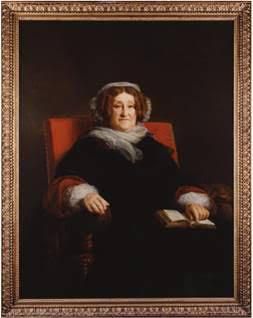In 1805 French women, like many women around the world, didn’t have the right to vote. She couldn’t gain admittance to colleges or universities or even secondary schools. Nor could she open a bank account in her own name.
Despite all that Barbe-Nicole Ponsardin Clicquot (aka “Madame Clicquot”) was a pioneering entrepreneur. Married at 21 and widowed at 27, in 1805 she took over her late husband’s champagne business which continues to thrive today. Not only did Madame Clicquot transform Veuve Clicquot to become a force in the industry, because of her, bubbly underwent a major metamorphosis.

Barbe-Nicole Ponsardin Clicquot
Courtesy Veuve Clicquot
“She risked her own inheritance to take over the company and continued to seize every new opportunity that arose allowing her to expand the business across the world while keeping in mind the demand for quality,” shares Anne-Sophie Stock, U.S. Vice President at Chandon, Moët & Chandon and Veuve Clicquot. “Madame Clicquot was a true visionary and changed Champagnes for centuries to come.”
In 1810, Madame Clicquot produced the first vintage wine in Champagne. By 1816, she invented a device called “the riddling table” to help clarify her champagne and make it effervescent. 1818, Madame Clicquot employed red wines from her Bouzy vineyards to produce the very first rosé champagne.
Known as a savvy businesswoman Madame Clicquot was able to earn the respect of her colleagues. “She would smuggle her wine out of France during the Napoleonic Wars finding a consumer base in the French and Russian armies,” says Stock. “Notably, one of her biggest customers was Tsar Alexander, who announced it was the only kind of champagne that he would drink.”
In a letter to her granddaughter Madame Clicquot wrote “Act with audacity.” And that became her mantra. “That tone marked her legacy as a winemaker and can inspire the women in wine and beyond to take risks and blaze new paths in their fields and beyond,” says Stock.
Stock offered more insight into Madame Clicquot.

Anne-Sophie Stock, U.S. Vice President Core Bubbles, Chandon, Moët & Chandon, Veuve Clicquot
Elizabeth Shrier
Jeryl Brunner: At a time when women couldn’t vote, Madame Clicquot was running the company. How was she able to do that and so successfully?
Anne-Sophie Stock: Madame Clicquot devoted many hours every day to her craft. She was a true student of wine and loved nothing more than establishing new ways to better her product and Champagnes in general. She wrote in a letter, “So we go day by day and do not despair.” This dedication and patience were instrumental in her success.
Brunner: How was Madame Clicquot forward thinking?
Anne-Sophie Stock: The growth of the business was fueled by her creative mind, audacious spirit and innovations. Some of them include the first vintage champagne, first rosé champagne and the riddling rack, which allowed her to make a higher quality champagne through a faster, more efficient process. The riddling rack allows bottles to be positioned upside down during the aging process so that sediment can be carefully removed, which gives champagne its bubbles and leaves the liquid crystal clear and not murky. This process is still used by a majority of champagne brands today.
Also, one of of Madame Clicquot’s greatest innovations was the rosé assemblage blending method. Rather than mixing champagne with elderberries to create a rosé champagne, she created her own red wine to mix with her white wines, resulting in a strong rosé with definite character.
Jeryl Brunner: How does Veuve Clicquot continue to support women?
Anne-Sophie Stock: Today, Veuve Clicquot is continuing Madame Clicquot’s legacy through our BOLD by Veuve Clicquot global initiative. It honors bold and iconic women while paving the path forward for future generations. BOLD by Veuve Clicquot was created to highlight a community of bold women around the world and ultimately become a program designed for more inclusion, impact and international visibility.
Jeryl Brunner: What might surprise people about making champagne?
Anne-Sophie Stock: Before being an incredible wine, Champagne is a place. Champagnes come from this small territory Northeast of Paris, which has a very specific terroir (meaning the soil, weather, climate, topography) that make the wines unique. Then, each bottle of Veuve Clicquot features three grapes: Chardonnay, Meunier and the star, Pinot Noir. This strong Pinot Noir presence makes our champagnes an excellent companion for any dinner. And finally, time is the unseen element. Each bottle is aged perfectly before being released by the winemaker.
What can you share about La Grande Dame prestige Cuvee which was released last month for Women’s History Month?
Anne-Sophie Stock: The La Grande Dame prestige Cuvée is the epitome of the greatness of women and our La Grande Dame (meaning “The Great Lady”). It is a champagne created in honor of Madame Clicquot. The current vintage, La Grande Dame 2012, is a limited-edition bottle created in partnership with world-renowned Japanese contemporary artist Yayoi Kusama, which parallels the two destinies of the two bold women living centuries apart.




